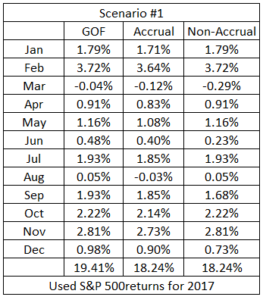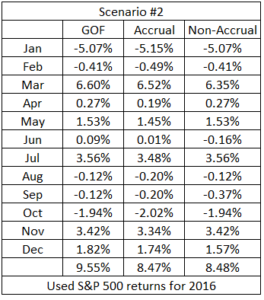I recently sent a suggestion into the GIPS(R) (Global Investment Performance Standards) Help Desk, suggesting that they introduce a recommendation, if not an outright ban, on firms deducting the annual fee from the annual gross-of-fee return, to arrive at their annual net-of-fee return, as part of GIPS 20/20. To me, this is far from accurate. But, there is nothing in the Standards to forbid it.
Yesterday, I had a brief email conversation with my colleague and friend, David Yuska, about this. He had chaired the development of a position paper on calculating net-of-fee returns several years ago; sadly, this paper never resulted in anything re. GIPS. He seems to agree with me that this practice is inappropriate.
I thought it fitting for those working on GIPS 20/20 to, at the same time they [hopefully] do as I suggest, remove the recommendation to accrue fees. A few years back I did a brief study to determine whether accruing advisory fees provided any benefits; I discovered that they did not.
But surely accruing advisory fees must make sense?
I shared my thinking with another colleague, who responded “if done correctly it obviously works so clearly there is something wrong in execution, your research or your conclusion.” This motivated me to have another look.
I believe that the suggestion to accrue arose from conjecture, only. That is, it must surely make sense, right? But, did anyone do any research to determine whether it actually did? I can’t say, but I did (both a few years back, and today!).
A test (actually two) to determine if accruing advisory fees provides benefits
I’m sure I can find my earlier research on this topic, but decided to conduct a brand new study, which is rather simple to do.
I did it twice. First, I used the S&P monthly returns for 2017. My annual fee is 1.00 percent. On a monthly basis this is not 1.00%/12, but rather [(1+1.00%)^(1/12)]-1, which yields 0.0829538 percent. Simply dividing 1.00% by 12 gives us 0.0833333 percent. While the difference is slight, it’s more accurate to do the additional bit of math.
Okay, so that’s the monthly fee.
The quarterly fee is therefore [(1+0.0829538%)^3]-1 or 0.2490679 percent. Note, I display the additional precision here, but normally wouldn’t.
With the accrual approach, we will deduct the monthly fee from each monthly gross-of-fee (GOF) return to arrive at the net-of-fee (NOF) return. With the non-accrual, we deduct the quarterly fee when charged/paid, on a quarterly basis.
Here are the first results (sorry if it’s a bit blurred):

As you can see, the difference between the annual returns is zero! We get the exact same results.
I tried this a second time, using the S&P monthly returns for 2016.
And the results are:

Here, we find a one basis point difference; what I would characterize as de minimis [need to toss in some Latin every once-in-awhile].
And so, does accruing advisory fees make sense?
As I discovered a few years back, it doesn’t. Why do this extra work?
“Recommendations” in the Standards are considered “best practice,” but in a few cases, I respectfully disagree. And this is one of those cases.
And what about deducting the annual fee from the gross-of-fee return?
As I stated above, this all began with my suggestion that the practice of simply deducting the annual fee from gross-of-fee should either be disallowed or at least discouraged. Consider what the results would be with what appears above.
In the first example, the GOF return is 19.41%, while the NOF (for both approaches) is 18.24 percent. By simply deducting 1.00% from the GOF we get 18.41%, which is materially different.
And, for the second example, the GOF is 9.55% while the NOF for the non-accrual method is 8.48%. By deducting 1.00% from GOF we get 8.55 percent. Perhaps not a “material” difference, but still incorrect.
We will have to wait and see if my suggestions result in anything with GIPS 20/20.
If you’d like a copy of my spreadsheet, just send me an email: DSpaulding@tsgperformance.com. Oh, and if you have a different view, or can find something incorrect in my procedures, please let me know! Your comments are always welcome!!!
A post script
Based on comments from Neil Riddles and Kim Cash, I thought it useful to compare the methods to derive what the quarterly or monthly fees should be. I do it slightly differently than apparently what most folks do. As Neil points out, most firms simply divide the annual by 1/4 to get quarterly, or 1/12 to get annual. Simple, but arguably both problematic and wrong. If you link these values, you will not get the annual fee amount; rather, you’ll get higher amounts (recall that simple averages fail to take compounding into consideration). Consequently you (don’t say this too loudly) may be overcharging your clients. Perhaps not by a lot, but ask them if they mind!
This table provides a comparison. As always, chime in!

